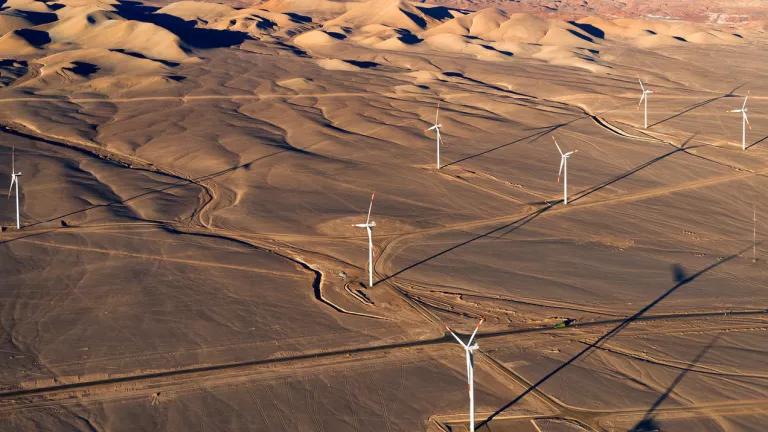Latin America’s 2020 Climate Leaders and Laggards
2020 was a turbulent year in Latin America—and a mixed bag on climate action. It will be important for the incoming Biden-Harris administration to put climate change front and center in its engagement with the region.

A wind farm in the Atacama Desert, Chile
2020 was a turbulent year in Latin America. Few countries in the region were not touched by massive protests, political upheavals, economic woes or catastrophic storms—with the COVID-19 pandemic on top of it all. Despite this, some leaders in the region have continued to make much-needed advances to curb climate change, particularly, Chile, Colombia and Costa Rica. Unfortunately, the region’s major economies—Brazil and Mexico—have instead backtracked on previous commitments and goals, which could potentially have terrible local and global effects. It will be important for the incoming Biden-Harris administration to put climate change front and center in its engagement with countries in the region to support the leaders as they advance on climate and to encourage the laggards to change course.
Climate Action Leaders
Chile
In April 2020, Chile became one of the first countries in the world to announce an updated Nationally Determined Contribution (NDC) under the Paris Agreement, despite ongoing political protests and COVID-19. Even though it’s still not deemed to be compatible with 2-degree or 1.5-degree scenarios, it is more ambitious than their 2015 commitment. In its updated NDC, Chile moves from an emission intensity-based target to an absolute emission reduction target of 95MTCO2eq by 2030 (not including the forestry sector), sets a carbon budget for the 2020-2030 period, and commits to peak emissions by 2025. Importantly, it also includes short-lived climate pollutants like black carbon. The NDC also covers several commitments related to nature-based solutions that go significantly beyond the original NDC, including explicitly integrating ocean protection with climate action.
Encouragingly, Chile’s new NDC is complemented by other positive climate actions. A proposed Climate Change Law will institutionalize the country’s commitment to achieve carbon neutrality by 2050. Chile also has a commitment to electrify all public transport and close all coal plants by 2040. In some cases, it is even moving forward with plant shutdowns ahead of schedule.
Colombia
Colombia’s President Ivan Duque announced that the country’s new NDC will include a target to reduce greenhouse gas emissions by 51 percent by 2030, up from the previous 20 percent target. While specific details about how these reductions will be achieved are still not pending, President Duque indicated Colombia will move forward with an energy transition, deploy clean transportation solutions and combat deforestation. Colombia will also plant 180 million trees by 2022, conserve Amazon and paramo ecosystems, and expand its Payment for Environmental Services system. Colombia is also adding new elements to its climate action efforts, including just transition and human rights concerns, black carbon reductions to improve air quality, and quantifying the ways that fighting global warming also benefits other sectors, like public health, education, science and finance.
Costa Rica
Costa Rica, a consistent leader on climate in Latin America, made a commitment to be carbon neutral by 2050 in 2019. The country released a Decarbonization Plan which details how the government plans to reach net-zero emissions through strategies like electrifying the public transport system, energy efficiency, and improved farming practices. Like most countries, COVID-19 has slowed some progress. But with the leadership on climate that Costa Rica has already shown, they will most certainly grow back “green.” And other countries should take note; a recent IDB analysis found that implementing the Decarbonization Plan would bring $41 billion in net benefits from 2020-2050.
Climate Action Laggards
Mexico
In Mexico, the Inter-Ministerial Climate Change Commission (CICC, Comisión Intersectorial de Cambio Climático) approved the country’s updated NDC on December 14. Yet instead of setting a progressively more ambitious target, Mexico merely “reaffirmed” the targets established 5 years ago: a 22 percent reduction in greenhouse gas emission and a 51 percent reduction in black carbon by 2030. These targets had already been deemed insufficient and, as it is, Mexico is not on track to meet even them.
The lack of ambition in the new NDC is one more worrying signal that Mexico is retreating from its previous leadership on climate and clean energy. Since taking office, the government of President Andrés Manuel López Obrador has slashed the budget dedicated to climate action, put an end to a public Climate Change Fund and repeatedly pushed forward policies to bolster the fossil fuel sector at the expense of renewable energy. In a joint statement, leading local organizations characterized the government’s actions as “a historical climate debt with its entire population; particularly, with the youth and children of this country, vulnerable populations and indigenous peoples, who are the most affected by the effects of climate change and to whom there has not been a timely and effective response.”
Indeed, the inaction and lack of ambition on climate runs contrary to Mexico’s own best interests. A study commissioned by the government and released last year quantified the benefits of key measures in Mexico’s NDC on livelihoods, food security, public health, water resources, employment and energy security. Among other things it found that generating 43 percent of electricity from clean sources by 2030 could increase employment in the electricity sector by 38 percent, reduce mortality, and create energy savings of at least US$1.2 billion in 2030. The benefits of climate action are clear. The costs of inaction are also evident, as seen with the recent back-to-back hurricanes that impacted southern Mexico and Central America.
Brazil
Brazil has been hit hard by COVID-19 under the administration of Jair Bolsonaro, and the president has used the pandemic as a distraction while he further dismantles environmental protections. It is then little surprise that Brazil’s recently updated NDC reduces the ambition of the country’s goals, becoming perhaps the only case of one of the world’s large emitters reducing the ambition of its pledge after adopting the Paris Agreement. Specifically, Brazil’s updated NDC effectively:
- Increases the amount of CO2 equivalent allowed by 2030 by 400 million tons when compared with 2015 target
- Increases the amount of CO2 equivalent allowed by 2025 by 460 million tons when compared with the 2015 target
- Allows Amazonian deforestation, one of the main factors in Brazil’s greenhouse gas emissions
According to Observatorio do Clima, a Brazilian environmental organization, Brazil’s NDC utilizes a carbon “trick maneuver,”—while it does not change the percentage mitigation pledge it drastically change the baseline. In other words, by 2030 Brazil pledges to emit around 400 million tons more of CO2 equivalent than what they indicated in 2015.
Brazilian deforestation rates have climbed with continued rollbacks of environmental policies in direct opposition to the country’s target of zero Amazonian deforestation by 2030. The agriculture sector, a major driver of deforestation and the second largest contributor to deforestation, is not even addressed in the new NDC. With 60 percent of the Amazon rainforest found in Brazil, this is some serious bad news.
Renewed U.S.-Latin America Relations Must Be Centered on Climate Change
As different as Latin American countries are, they all share high levels of vulnerability to climate change. From worsening storms in Mexico and Central America, to water stress in Chile, to regional economic impacts as changing climatic conditions impact agricultural sectors and fisheries, climate change is already felt firsthand in Latin America. All countries in the region need to take action—urgent, ambitious, drastic action to build resilience for their communities and reduce emissions from energy sectors and land use.
Partnering on climate change offers an umbrella for the new, more climate-forward U.S. administration to engage with the region. The incoming Biden-Harris administration will need to work to put climate change front and center in its diplomacy, development strategy and trade relations with Latin American nations. It will be important to build constructive and mutually beneficial partnerships to support countries who are leading in the climate space, and to work with the laggards like Mexico and Brazil to reverse alarming trends that threaten the future of communities all along the Americas.






